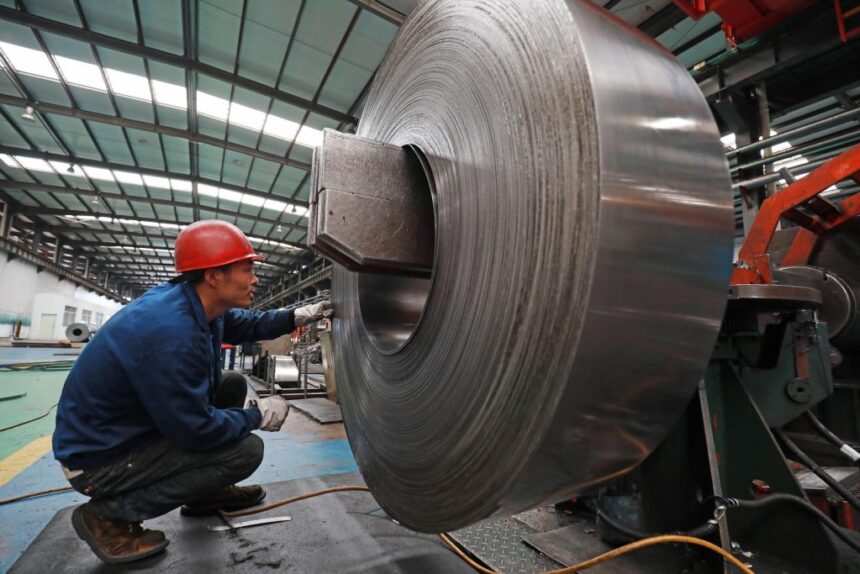
By Qiu Ju and Chen Xi
As the COP29 climate conference wrapped up in late November, it became clear that its legacy would be uncertain regarding global climate action cooperation. Attendees did predominantly agree on one thing, however. Companies should publish their climate targets and contribute to the energy transition.
According to the UN’s 2024 Emission Gap Report, 107 countries, covering approximately 82% of global greenhouse gas emissions, had adopted net-zero pledges as of June last year. Meanwhile, more than 9,000 companies have committed to actions to cut global emissions by 2030.
China’s carbon emissions have not yet peaked, but its rapid expansion of renewables means they are likely to soon. As the world’s biggest emitter, a plateau in China’s emissions would be significant. However, with economic growth slowing and coal consumption still on the rise, there have been signs that improvements in energy intensity are slowing. National carbon intensity goals are also heading somewhat off-track.
Moreover, our recent report, produced by colleagues at the China Europe International Business School’s Lujiazui International Institute of Finance, reveals slow progress among Chinese firms in making climate pledges and taking climate action.
But in every crisis, there is opportunity. China is preparing to introduce a cap on total carbon emissions while adjustments are being made to international trading rules. Both could accelerate progress.
Value chain emissions need cutting
Even with legal restraints and appropriate policies, hitting net-zero targets will require businesses to respond actively. Listed companies should be exceptionally motivated, thanks to disclosure requirements and public opinion over share prices.
In 2023, China’s listed firms earned CNY 72.7 trillion (USD 9.9 trillion). That represents 57% of the GDP. Researchers have calculated that, in 2019, the total scope 1 carbon emissions of China’s listed firms accounted for 18.3% of national emissions. That jumps to 43% when scope 2 and 3 emissions are added. As the total sales revenue of China’s listed firms has typically grown faster than its GDP in recent years, it can be assumed that those percentages have only risen since 2019. Therefore, it is essential for China’s climate commitments that its listed companies wield their influence to cut whole-lifecycle emissions up and down their products’ value chains.
However, most Chinese firms are not required to make climate disclosures. Carbon emission caps, meanwhile, are not yet being enforced and existing carbon markets are limited in scope and force. Firms are, therefore, not feeling the pressure to cut emissions. Any action is more likely to be driven by marketing than fundamental changes in the value chain, which are usually related to cost increases.
Business is slow
Our research references two Bloomberg Terminal ESG (environmental, social and governance) business databases. One is BI Carbon, which covers 432 heavily emitting firms (52 of them Chinese) in sectors such as energy, transportation, chemicals, cement and steel. The other concerns business information and contains emissions data for 1,080 listed firms (114 Chinese) across 62 countries.
Looking solely at heavily emitting firms, 68% have made climate pledges, but only 25% of the Chinese firms have. This is far below Europe and Latin America, both at 80%, or even North America and Asia-Pacific, both at 60%.
Furthermore, these Bloomberg datasets reveal that the median combined scope 1 and 2 carbon emissions for listed firms internationally is now half that of a decade ago, while median carbon intensity has fallen by a third. Chinese companies do not follow this trend. Their median for carbon emissions has increased by 7.2%, and the median carbon intensity has only fallen by 9.7%. It is worth noting that these datasets are missing considerable amounts of pre-2016 data for Chinese firms, but the country’s actions and outcomes are clearly lagging behind.
Retail and services lead the way
Breaking things down by industry, we found that the growth in renewables helped the fuel-production and power-generation sectors reduce carbon intensity significantly between 2016 and 2023. Yet these sectors’ combined total median emissions still rose by 45%. This is because growing energy consumption undermined emissions reductions. The emissions intensity of the metals and chemicals industry grew by 17%, while the manufacturing and technology sectors saw relatively small changes both in carbon intensity and emissions figures.
The only sector to see both carbon intensity and emissions fall between 2016 and 2023 was consumer goods and services, which covers food and drink, retail and tourist accommodation. This sector’s emissions fell by 16%. Three-quarters of that was due to carbon intensity improvements, while the remainder was down to declining sales.
Technological improvements, policy guidance and regulations have been key to reducing retail-end emissions. For example, the take-up of electric vehicles has rocketed, cutting fuel emissions. Also, a steady ratcheting up of single-use plastic rules is shrinking the energy demands and associated emissions of packaging. The twin emissions dips in consumer goods and services may also have been helped by increasing awareness of sustainability issues among consumers – particularly young consumers. Companies will respond to this by focusing more on green and low-carbon approaches to design and production.
Business is set to speed up
Most Chinese firms will not feel any urgent need to cut carbon emissions until caps are put in place, but the situation is changing.
In August, the State Council confirmed that from 2026, China will shift away from controlling energy consumption and towards controlling carbon emissions. The Ministry of Ecology and Environment has recently published requirements and guidance on how to measure a product’s greenhouse gas footprint and cut emissions and is establishing carbon accounting methodologies and databases. China’s carbon markets expanded in 2024, too, to include the cement, steel and aluminium sectors. This increased the percentage of national emissions covered by the market from 40% to 60%. Further expansions are expected.
Sustainability reporting
Meanwhile, carbon disclosure rules for listed firms are being standardised and toughened up. In April 2024, the People’s Bank of China and other government bodies issued guidance on how finance can support green and low-carbon development. China’s three major stock exchanges then issued guidance on sustainability reporting for designated firms – including a requirement to disclose greenhouse gas emissions.
Once carbon footprints are visible, investors will be able to evaluate a firm’s carbon risks. That is, potential financial and operational damage arising from climate change, carbon emission controls or the low-carbon transition. This will create internal pressure for firms to respond to these risks and cut emissions.
Carbon tariffs
Finally, Chinese firms will find themselves increasingly affected by “carbon tariffs”. The EU’s carbon tariff (CBAM) began to be implemented in 2023, with an initial transition period running up until 2025. This currently affects Chinese firms in a few sectors only, including steel, cement, aluminium and fertilisers. However, CBAM expansion is now up for discussion, and given the EU’s tough carbon accounting requirements, the possibility of more Chinese firms being affected is raised.
Elsewhere, the UK has announced that its version of CBAM will come into effect in January 2027. In the US, there is ongoing debate regarding a carbon border tax, such as the Republicans’ proposed Foreign Pollution Fee Act, the scope of which would cover China’s major export sectors.
Transforming carbon-cutting into growth opportunities
Chinese firms will be pushed to cut emissions through tougher reporting requirements, green trade barriers, and state-level economic planning incorporating total carbon emissions data. However, slowing domestic economic growth and international trade tensions are creating strong headwinds. For Chinese companies, the ability to turn carbon-cutting pressures into growth opportunities will be critical to prosperity.
Qiu Ju is a researcher at the China Europe International Business School’s Lujiazui International Institute of Finance.
Chen Xi is a researcher at the China Europe International Business School’s Lujiazui International Institute of Finance.
First published in Dialogue Earth.
Discover more from A greener life, a greener world
Subscribe to get the latest posts sent to your email.







